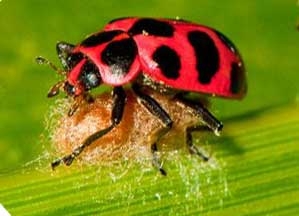Understanding parasite mind control (continued)
Thirty-two years later, scientists are finally opening the black box of parasite mind control.
Frederic Libersat of Ben-Gurion University and his colleagues, for example, are dissecting the sinister attacks of the jewel wasp, Ampulex compressa.
The wasp stings a cockroach, transforming it into a passive zombie. The wasp can then walk its drugged victim into a burrow by the roach's antenna, like a dog on a leash.
The roach is perfectly capable of movement. It just lacks any motivation to move on its own behalf.
The wasp lays an egg on the roach's underside, and the roach simply stands there as the wasp larva emerges from the egg and digs into its abdomen.
What is the secret hold that the wasp has over its victim? Libersat and his colleagues have found that the wasp delicately snakes its stinger into the roach's brain, sensing its way to the regions that initiate movements.
The wasp douses the neurons with a cocktail of neurotransmitters, which work like psychoactive drugs. Libersat's experiments suggest that they tamp down the activity of neurons that normally respond to danger by prompting the cockroach to escape.
The scientists have documented the jewel wasp's neurosurgery in astonishing detail—but they're a long way from the full story. The wasp's venom is a veritable punch bowl of different chemicals, and Libersat and his colleagues have yet to determine which ones affect the behaviour of the cockroach and how they do.
But so far their research is entirely consistent with Dawkins's theory of the extended phenotype: The genes that encode the venom molecules enlist the cockroach in the wasp's survival plan by providing an ideal nursery for the wasp's young.
Baculoviruses
In a handful of cases scientists have begun to pinpoint which of the parasite's genes control their host's behaviour.
Baculoviruses, for example, infect the caterpillars of gypsy moths and a number of other species of moths and butterflies.
The parasite invades its host's cells, hijacking them to make new baculoviruses. On the outside the caterpillar appears normal, continuing to munch on leaves as before. But the food it eats is not becoming more caterpillar tissue. Instead it's becoming more baculoviruses.
When the virus is ready to leave its host, the caterpillars undergo a radical change. They become agitated, feeding without rest.
And then they begin to climb. Instead of stopping in safe spots out of the way of predators, the infected caterpillars creep higher into the trees, remaining on top of leaves or on tree bark in daylight hours, when they are easily seen by predators.
The baculoviruses carry genes for several enzymes. When they're ready to leave their host, certain genes become active in caterpillar cells, producing a torrent of enzymes that dissolve the animal into goo. As the caterpillars dissolve, clumps of viruses shower down onto the leaves below, to be ingested by new caterpillar hosts.
To Kelli Hoover and David Hughes of Penn State University and their colleagues, the climbing behaviour of the caterpillars seemed like an exquisite example of an extended phenotype.
By causing their hosts to move up in trees, the baculoviruses increased their chances of infecting a new host down below. To test Dawkins's idea, they examined the genes in baculoviruses, to see if they could find one that controlled the climbing of caterpillars.
(continued next issue)
See this article in Tree Fruit March 2015




















